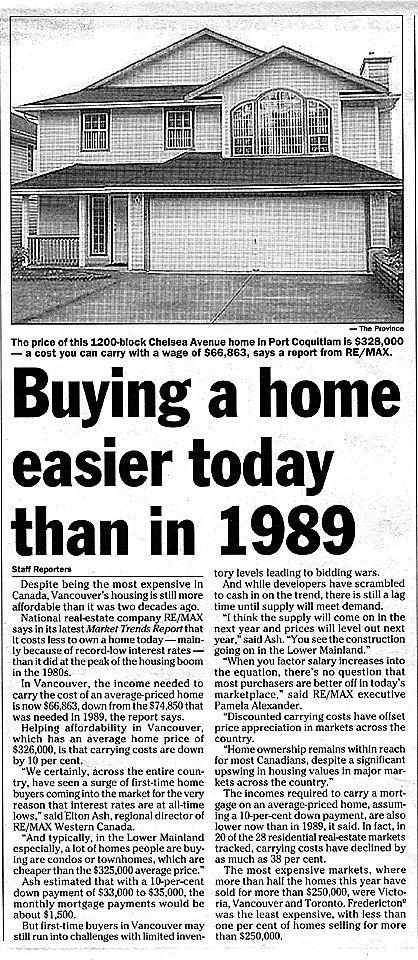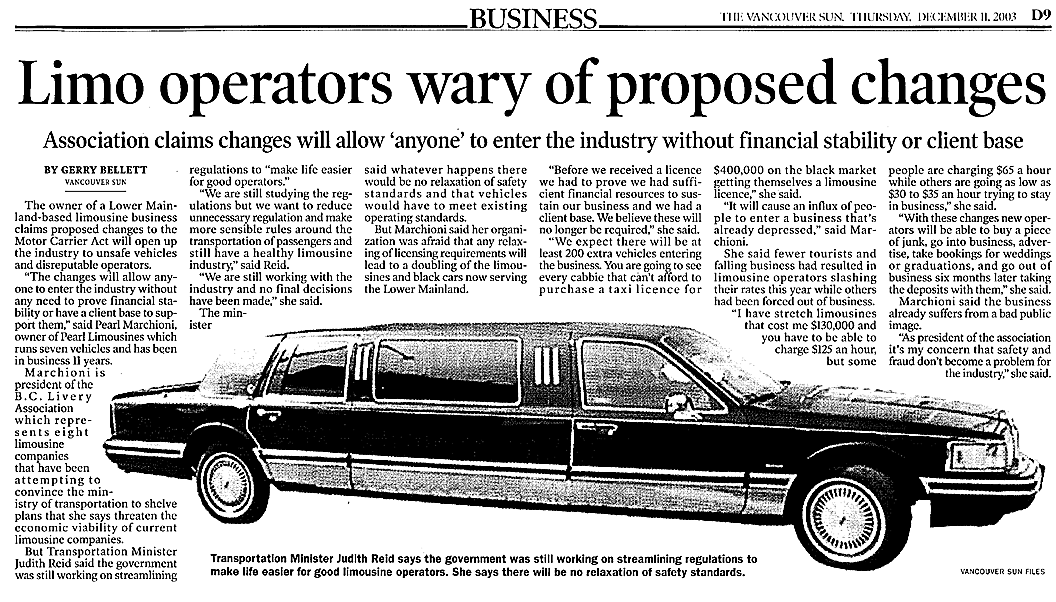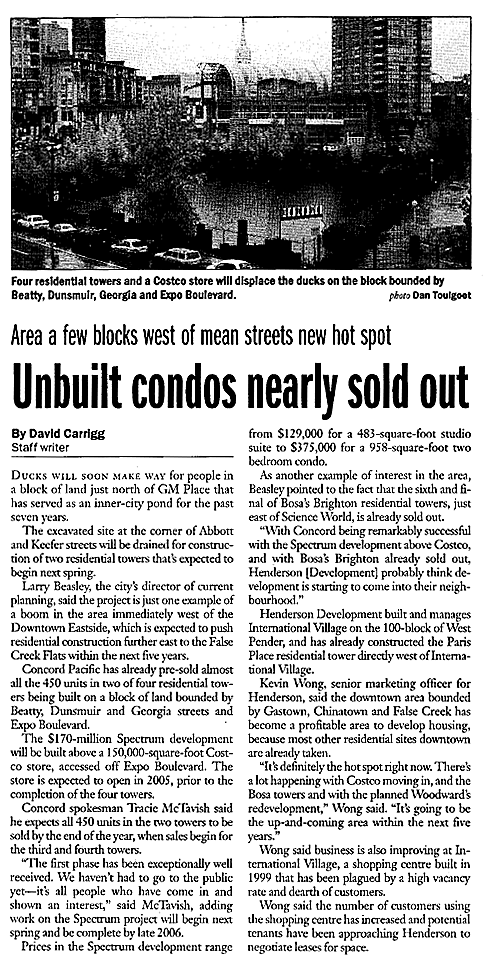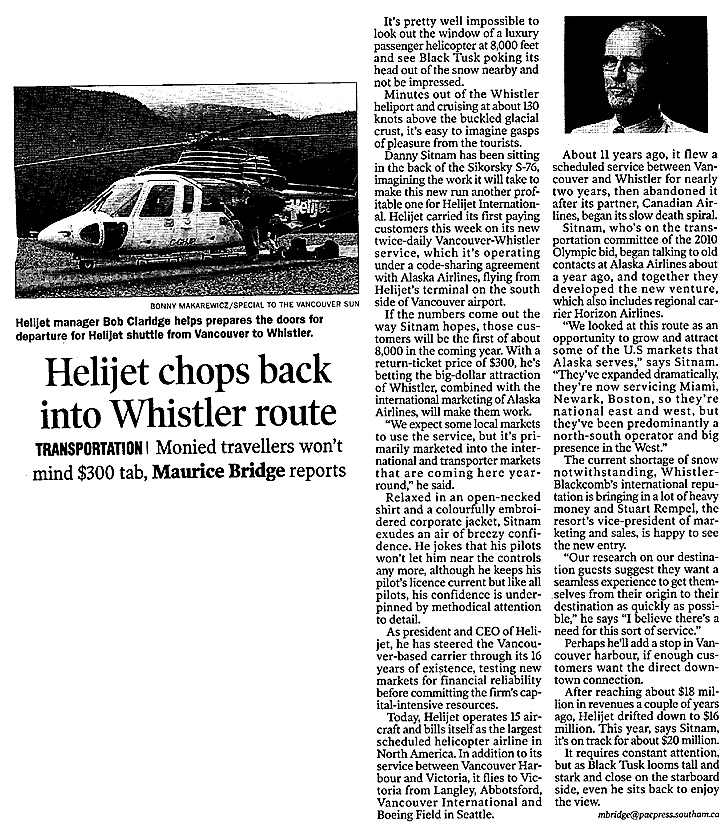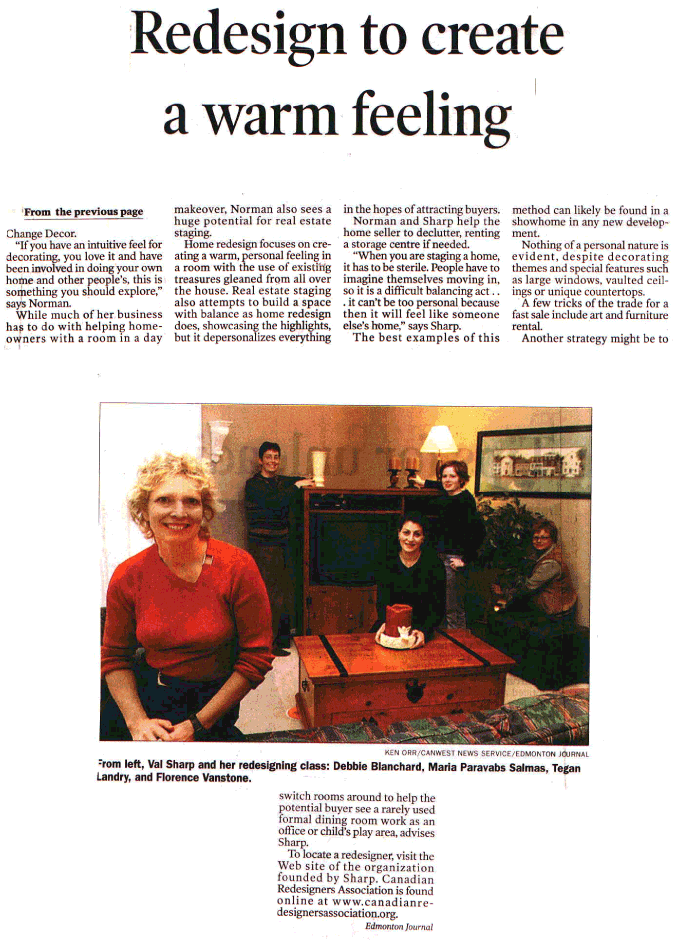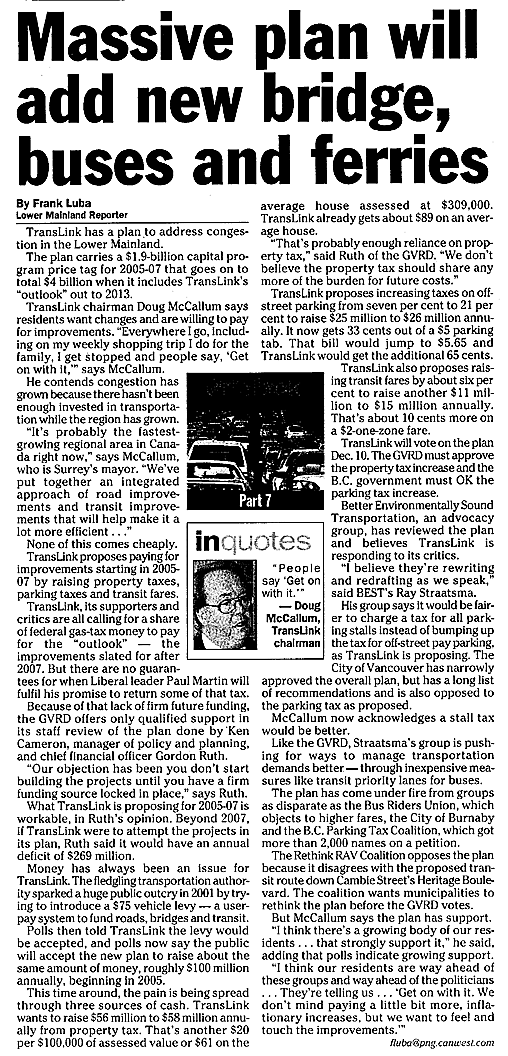Frank Luba
Province

Upgrading of Pattullo Bridge and two others to cost $54 million. CREDIT: Colin Price, The Province
Residents of the Greater Vancouver Regional District will pay increased property taxes, higher transit fares and a controversial new parking fee to pay for $1.9 billion worth of roads, bridges and public transit approved yesterday by TransLink, the regional transportation agency.
Details of the parking fee have yet to be worked out but that particular proposal has incensed the owners of shopping malls and commercial buildings.
“It simply won’t get people out of their cars,” said Retail B.C. president Mark Startup.
TransLink board members were divided in their support for the ambitious plan for 2005-2007, to be paid for by new taxes, fees and fares that would raise about $100 million a year.
Board chairman Doug McCallum refused to allow the options to be separated for individual votes and debates.
Although challenged by Vancouver Coun. Fred Bass, the board supported McCallum’s ruling and eventually approved the plan.
McCallum acknowledged there were problems with the plan but hailed the final decision.
“We have parts of the plan that people don’t like and we need to work with those people as we go over the next few years . . . to listen to their concerns,” he said.
“I think it’s a historic day for transportation in our region, that we’re going to move ahead now.”
Bass voted against the plan, breaking ranks with his fellow COPE members from Vancouver: Mayor Larry Campbell and Coun. David Cadman.
Bass objected to the plan because of the financial risk involved in building the $1.5- to $1.7-billion rapid transit line proposed to link Richmond, Vancouver International Airport and Vancouver. TransLink’s plan includes a $370-million contribution to the cost of the so-called RAV line, with the remainder to be raised by the federal and provincial governments and a private partner.
Bass said the plan lacked support for buses, which carry more than 70 per cent of all transit users. He also objected to backing a plan that isn’t funded beyond 2007.
The $1.9-billion three-year plan is part of a proposed $3.9-billion package of transportation needs that TransLink is proposing for the next 10 years.
“To push through a plan that incorporates the biggest public project ever to be done [in the Lower Mainland] and to not have the money in hand, not know where it’s coming from, and to spend all our money on RAV and roads is wrong,” said Bass.
TransLink’s plan was supported by groups as diverse as the B.C. Federation of Labour — whose president Jim Sinclair spoke out in favour of it at the last public meeting on the plan — the B.C. Automobile Association and transit advocates Better Environmentally Sound Transportation.
But the board’s approval was a bitter pill for the Rethink RAV Coalition. The group fought the plan because it opposed the rapid transit line going down the Cambie Heritage Boulevard in the city of Vancouver when the Arbutus corridor would be less expensive.
Spokesman Don Toffaletto was “extremely disappointed.”
“We think it’s time property owners and renters that are going to be hit with this [increased costs] started some kind of revolt,” said Toffaletto.
Besides Bass, board members who opposed the plan were Pitt Meadows Mayor Don MacLean, New Westminster Mayor Wayne Wright and North Vancouver City Mayor Barbara Sharp.
Leading the group in favour of the plan were McCallum, who is mayor of Surrey, and Surrey Coun. Marvin Hunt, who will now have to steer the proposal through approval for property tax increases by the GVRD board, where he is the chairman. Also in support were Richmond Mayor Malcolm Brodie, Langley City Mayor Marlene Grinnell, Port Moody Mayor Joe Trasolini and Port Coquitlam Mayor Scott Young.
WHERE ALL THOSE MILLIONS ARE GOING TO BE SPENT
Some highlights from TransLink’s $1.9-billion capital plan approved yesterday:
ROADS
:: Major roads, $105 million (a further $125 million accumulated in earlier years).
:: Minor roads, $60 million.
:: Transit-related roads, $9 million.
BRIDGES
:: Rehabilitation of Pattullo, Knight Street and Westham Island bridges, $54 million.
:: New Fraser River crossing between Langley and Maple Ridge-Pitt Meadows, $600 million (to be paid for with tolls).
TRANSIT
:: Contribution of $370 million to Richmond-Airport-Vancouver rapid-transit project (which costs between $1.5 billion and $1.7 billion).
:: Northeast-sector rapid transit, $400 million (contribution toward estimated final cost of $900 million if SkyTrain technology is used).
:: Replacing 492 bus and custom vehicles (including new trolleys), $312 million.
:: Maintaining infrastructure, including new depots and new maintenance centre, $200 million.
:: Expanding bus and HandyDart fleet by 156 vehicles, $59 million.
:: Payments toward 34 new SkyTrain cars, $84 million.
:: New West Coast Express station and spare locomotive, $10 million.
:: Cycling infrastructure, $15 million.
:: SeaBus retrofit, $5 million.
HOW IT WILL BE PAID FOR, BEGINNING IN JANUARY 2005
:: PROPERTY TAX :: TransLink will raise $56 million to $58 million annually from property tax by charging an extra $20 per $100,000 of assessed value.
That works out to another $61 on the average assessed value of $309,000, from which TransLink already takes about $89.
:: TRANSIT FARES :: These fares, which rose in 2002 by 25 cents for single-zone and 50 cents for two- and three-zone rides, will go up by about six per cent to raise another $11 million to $15 million annually.
Exactly how that will be done hasn’t been determined but it basically works out to about 10 cents more on a single-zone fare, which is currently $2.
:: PARKING TAX :: Since discussion began about TransLink’s new plan, the proposal focused on increasing parking taxes on off-street pay parking from seven per cent to 21 per cent in order to raise $25 million to 26 million annually.
Because of widespread opposition from downtown Vancouver, where the bulk of pay parking exists, the other option has been chosen — a tax on either the parking-lot area or number of parking stalls across the region, which would cost about $28 per stall.
This has raised great opposition from shopping malls and commercial buildings. Exact details on the stall tax have yet to be worked out but the seven per cent on off-street pay parking will be retained.
© Copyright 2003 The Province

